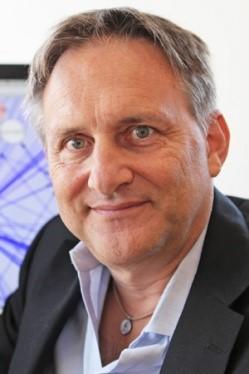Andrea Califano, Ph.D., a CSBC investigator at Columbia University, studies proteins that control cellular networks, known as master regulators, and their role in cancer progression.
As a post-doc in physics at MIT, he was excited by the emerging areas of artificial intelligence and machine vision. Then, he worked for IBM where he developed algorithms for pattern discovery and applied mathematical models to biological data.
However, according to him, he transitioned to academic systems biology research because, “I wanted to put my money where my mouth was and have a chance to experimentally validate my computational predictions.”
In this interview, he discusses challenges and support during his career and describes his CSBC-supported research.
What challenges have you overcome during your career?
The biggest challenge, in the beginning, was the skepticism of traditional molecular biologists. They thought we were playing interesting games with biological data but not producing anything relevant.
When I first presented the hypothesis that a handful of master regulators are responsible for regulating the state of all tumor cells, biologists considered it an interesting but abstruse theory with little bearing to actual cancer biology.
One reason is that the complexity of biological systems is difficult to grasp. Biologists have been extremely good at solving difficult problems by keeping everything fixed except the one gene or protein they were studying. Yet, in a cancer cell, everything moves and applying a gene by gene approach can be misleading. There’s still skepticism about complex models, but the large volume of experimentally validated discoveries that have originated from these methods is such that systems biologists are now taken more seriously.
Who has helped you during your career in cancer systems biology?
NCI started supporting systems biology long before the field delivered important biological insights and translational findings. There are real visionaries at NCI who pushed this research agenda forward. They are trying to make sure the integration of physics and mathematical approaches with biology is pursued to its full potential.
What are a few of the software programs that you have developed for systems biology studies?
My lab developed an algorithm called ARACNe, which was the first method to reverse engineer the transcriptional logic of human cells. Using information theory, we could recover accurate maps of specific targets of transcription factors in a context-specific manner. Our publication describing this algorithm has been cited by hundreds of other manuscripts.
VIPER is the key algorithm that leverages the regulatory networks assembled by ARACNe to systematically identify master regulators of tumor cell states. It has been used to study dozens of tumor-related phenotypes.
We are currently developing two algorithms, OncoTarget and OncoTreat, to improve the clinical treatment of cancer. OncoTarget can identify if a protein that is activated in an individual cancer patient can be targeted by a current cancer drug. OncoTreat finds the proteins that are regulating a patient’s tumor and determines what cancer drugs can block their activity. Both algorithms are being used in multiple clinical trials.
What is the hypothesis of your CSBC-supported research?
We hypothesized that in cancer cells, multiple events converge to induce activation of proteins called master regulators. These master regulators work together within tightly autoregulated modules to ensure the stability of the cancer cell state.
Think of this cellular machinery as an air conditioner. When the temperature of a room goes a little bit above or below the set point, loops in the system signal for adjustments to maintain a stable temperature. Thus, master regulators act like environmental sensors that prevent changes in the environment, such as the delivery of a drug, from producing catastrophic effects in the cancer cell. They prevent cancer cells from becoming unstable and easy to kill.
My lab examines master regulators and their networks. This allows us to understand the key genetic events and vulnerabilities of the cancer cell that can be used for treatment. We look for one or more drugs that will collapse the entire master regulator module and kill the cancer cell.
Can you describe your Cancer Discovery study?
By concentrating on the modularity of cancer regulatory pathways, we found that two proteins, TEAD4 and MYCN, upregulate each other in an aggressive subtype of neuroblastoma through a vicious, positive feedback loop.
We also showed that blocking this loop by inhibiting TEAD4 could rapidly kill cancer cells in experimental models. The results suggest that TEAD4 may be a potential prognostic marker and therapeutic target for a type of brain cancer involving MYCN amplifications.
